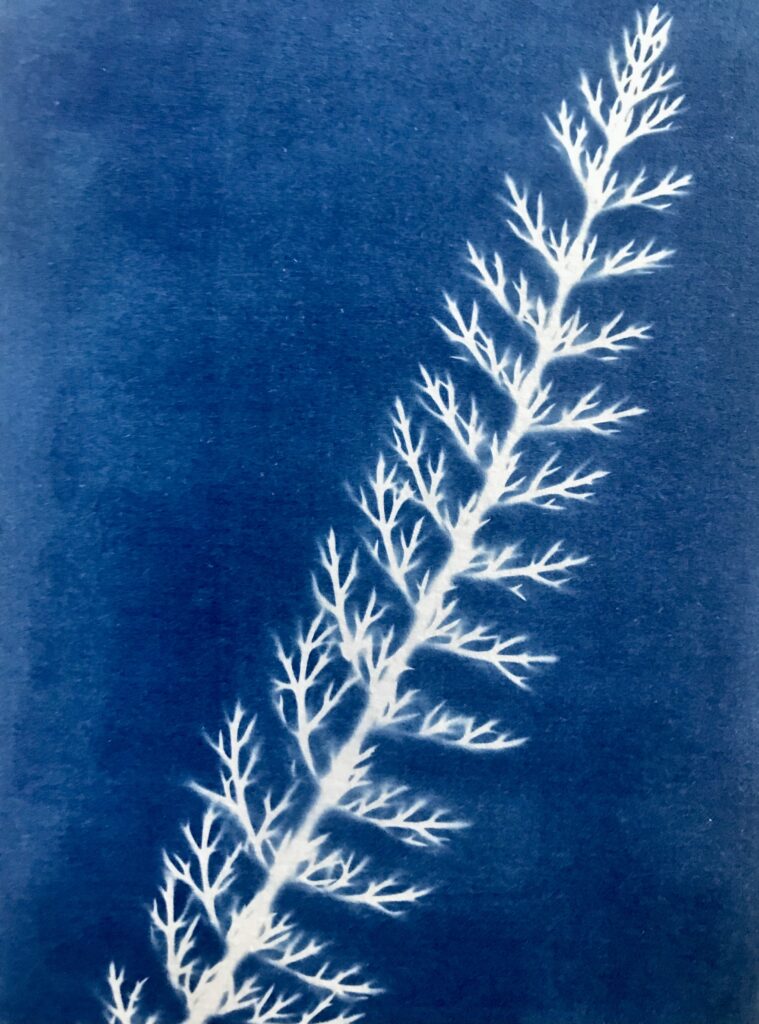
This post forms part of a monthly series that documents the plants growing at The Angel of the North through a series of cyanotypes.
In my March post I noted the arrival of Spring, with the daffodils in flower under the trees that form the memorial garden at The Angel of the North. Although some of these daffodils are still blooming, I turn my attention for the month of April to the fern-like foliage of two other plants that grow on the Angel site, and that will come into flower in the summer months: yarrow (the feathery foliage of which is depicted above), and tansy (a serrated frond of which is shown below). Both of these plants thrive on disturbed ground, such as roadsides and waste land, so it is unsurprising that they are growing on the former pit site where The Angel stands. The more delicate yarrow, with its clusters of small white flowers from June to August, can be found in the field in front of The Angel. The compact golden buttons of the tansy can be seen there from July to October, and its flowers also line the path that leads up out of the trees towards The Angel.
In addition to thriving in the same kind of conditions, yarrow and tansy are also linked by having been used for medicinal purposes from the time of the ancient Greeks. This medicinal association is reflected in their names: yarrow’s Latin name, Achillea millefolium, connects it to the warrior Achilles, who was said to have applied the plant to the wounds of his bleeding soldiers; while tansy’s common name is derived from the ancient Greek word for immortality (Athanasia), because in Greek mythology Zeus gave the shepherd Ganymede a drink of tansy to make him immortal. Folk names for these plants also gesture to their healing properties. Yarrow is variously known as soldiers’ woundwort, staunch grass, blood wort, and herb militaris – names that reflect its historical (and military) use to stop bleeding. Tansy is also called bitter buttons, referring to its tartness when drunk as a tincture to ease digestive problems.

In addition to staunching wounds, yarrow was also added to ointments, due to its soothing and anti-inflammatory properties. It was a popular infusion for colds, and it was known to lower blood pressure and to relieve indigestion. Tansy likewise had a range of uses, including the treatment of fevers and of sores. However, the plant can be toxic if too much is used, or if there is an existing allergy to it; BBC presenter Sue Perkins experienced tansy poisoning on the documentary Supersizers . . . Go Restoration, when she sampled an historical recipe in which the plant would have been used.
Because of its medicinal properties, yarrow became associated with good luck and protection, and it was pinned to cradles to guard newborn babies against harm. Tansy’s ability to repel insects meant that it was often placed in the coffin with the dead to help preserve and protect the corpse before burial. In Yorkshire, biscuits flavoured with tansy and caraway seeds were traditionally served at funerals.
The foliage of these plants is easily overlooked before they come into flower, but the distinctive fern-like fronds that are visible at this time of year act as reminders of these resilient plants, as well as having their own delicate beauty. The plants’ long association with healing, the dead, and protection gives them a particular resonance in the context of this project’s interest in the memorial garden that is located at the feet of The Angel, and it feels apt that they grow amid the grasses there, even if they largely pass unnoticed.
